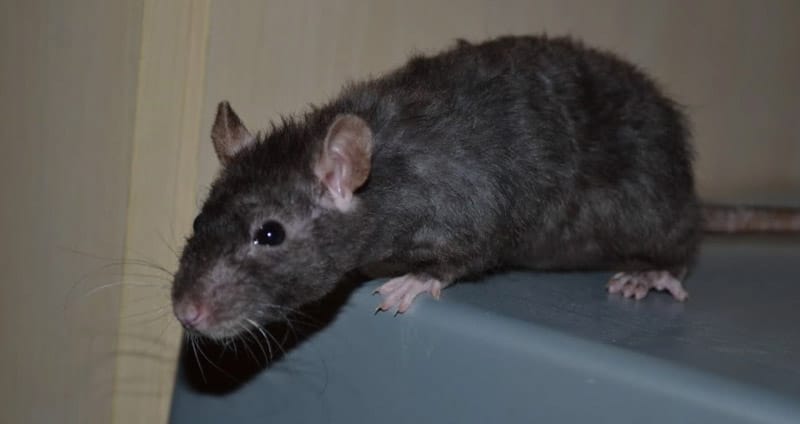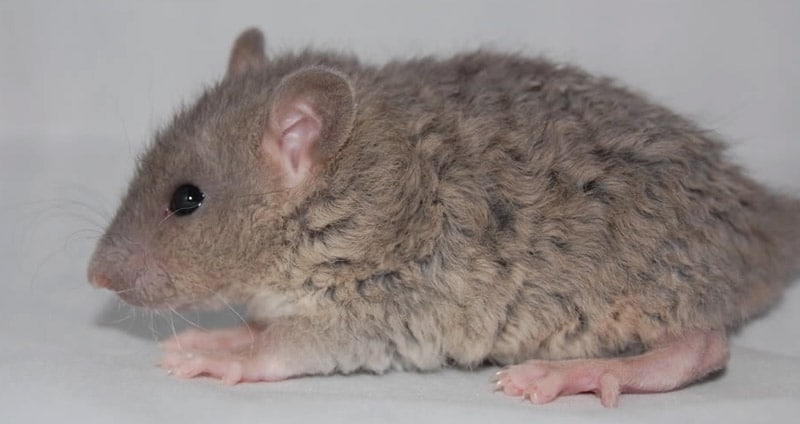The Rex rat is one of the most beloved and unique kinds of rats that exist today. Even if someone has never seen a normal rat in person, they’ll immediately notice (and exclaim their appreciation of) a Rex’s curly coat and wild whiskers. This adorable appearance and soft coat that begs to be touched have made the Rex rat a favorite rat among breeders, showers, and casual rat owners alike.
Table of Contents
History Of The Rex Rat
The Rex rat first came into existence back in the year 1976 when they were first bred in England by a geneticist named Roy Robinson. That year, they were standardized by the National Fancy Rat Society, thus starting their spread around the world. It only took a few years for Rexes to make their way into the US and grow in popularity.
The first Rex rats in the US came around a bit before 1983 and were acquired from private sellers, universities, or specialized pet shops. Mary Sheridan showed the first two recorded Rexes on October 8, 1983. In late November of 1983, just after this showing, the first 3 English Rex rats were imported into the US. These were a Black Berkshire Rex, a Black Shelf Rex, and a Cinnamon Rex.
These initial Rexes were quickly bred to other rats to create some particularly amazing Rex specimens with more pronounced characteristics. As time has gone on, Rex rats have only become more popular and well-liked by all kinds of people. Their appearance is simply something that’s not seen frequently, so it’s acted as a way to grow the popularity of this rat.
Rex Rat Physical Appearance
The Rex is distinguished and defined by one main trait, and that’s its unique, curly hair. The hair can be any color and can vary greatly in the tightness of the curls, but the curls are present nonetheless. The NFRS has created standards to use in defining a Rex rat, and they are:
- Coat is evenly dense and not excessively harsh
- As few guard hairs as possible
- Coat is evenly curled with lesser curls on the belly
- Color conforms to a recognized color or color pattern
One thing to note is that a rat may be classified as a Rex rat, but that doesn’t mean that every Rex rat is the same. Some are simply created to be much more attractive and stylized than others. “Good examples” of Rex rats are actually quite difficult to come across, and many people may never see a good example due to this.
You’ll see the most uniformity and conformity to the NFRS standards in Rex rat babies. These babies first develop a very tightly-curled coat as seen in the rat specimen above. However, after about a month and a half or 6-7 weeks, they moult into their adult coat and most of the curl disappears to be replaced with waves.
For females and most males, they’ll simply never return to their former glory when it comes to their coat. Although their coats may undergo a few slight changes, they won’t come close to the tight curls that they first developed. However, some males will regain their former glory and develop a coat that’s just as curly and luxurious.
Unfortunately, this glory doesn’t last for a long time. For essentially all Rex rats, their coats tend to have the tendency to thin and bald as they age. In fact, it’s very common for 18-month-old Rexes to have very thin and patchy coats. Many owners may think that this is because their Rex is sick or stressed, but it’s simply an unavoidable result of their genetic makeup.
Rex Rat Genetic Breakdown
The genetic makeup of a Rex rat is quite fascinating to learn about, as they’re not the only kind of rat that can experience curly hair. Rexes are produced by the dominant gene Re, and this is a gene that’s independent of the genes for things like color and pattern. Therefore, you’re able to breed a Rex rat with any other rat and get some Rexes in the litter. This results in the possibility to combine the trademark Rex coat with any other marking or color that exists.
The Re gene isn’t the only gene that results in a rat having a curly coat. In fact, Roy Robinson in Genetics of the Norway Rat highlighted 5 genes that resulted in curly hair.
- Curly-1 (Cu1) – A dominant gene resulting in a curled coat at 2 weeks old, the coat disappearing after less than 2 weeks, and then reappearing on the rear of the rat at around 7 months of age.
- Curly-2 (Cu2) – Another dominant gene that results in fewer guard hairs, a curled and rough undercoat, and curly whiskers from birth.
- Kinky (k) – A recessive gene that creates curly whiskers, short rough coats in adults, and short dense coats in younger rats. These traits are very stable and consistent throughout the life of a rat.
- Shaggy (Sh) – A dominant gene similar to Curly-1 and Curly-2. A combination of Cu1 and Sh result in a curlier coat than just the Cu1 gene.
- Cowlick (cw) – A recessive gene that results in a whorl of hair in the middle of a rats back.
Unfortunately, most of these genes are not present within fancy rats. Many breeders would absolutely love to utilize these characteristics to create show-ready rats. However, a combination of these genes may be responsible for some of the more impressive Rex specimens and may explain why such good-looking Rexes are so hard to come across.
Rex Rat Breeding
Due to the simple genetics of a Rex rat, breeding isn’t a very difficult subject for this kind of rat. The Rex gene is dominant, meaning that breeding a Rex rat with any other kind of rat will result in about half of the babies in the litter being Rex. This makes the creation of more Rex babies very easy!
One note of warning to all potential Rex breeders is that two Rexes should never be bred together. Although it may seem like the smart thing to do, it can actually result in a worse offspring. Babies of Rex mothers and fathers have coats that are not what you would be looking for if you’re trying to breed a good Rex. These homozygous Rexes have coats that are very thin and patchy, and in some cases they’re nearly hairless! Although they’re entirely healthy, their appearance leaves much to be desired.
In order to breed good Rexes, you need to start with good Rexes. You’ll want to have an adult buck with an optimal coat that has very tight curls and a widely-compatible color. While it can be very hard to come across a Rex rat to keep and use as the father, many established breeders will offer a stud service. This is a great way for new breeders to get into the game and get high-quality offspring.
When Rexes are young, it’s very difficult to tell if they will grow up to be strong Rexes. It’s easy to tell if they will be a Rex in the first place, as babies will have curly whiskers. Most breeders typically keep the babies with the most curly whiskers and see how they develop from there. Once the babies reach about 6 months of age, they are judged to see if they are fit for showing or if they should just be kept as a normal pet.
With the frequency of high-quality Rexes being quite low, Rex rat breeding can result in breeders possessing a large amount of Rexes as they look for the best specimens. Therefore, the rats that don’t make the cut can generally be purchased for very low prices.


Photo by AnnSoo1990
Purchasing Rex Rats
You don’t have to be in the show business to appreciate these wonderful rats. Rex rats make for great pets and are loved for their soft coats and slightly curled whiskers. If you would like to make a Rex rat your new companion, there are a few things that you’ll want to make sure that you do.
You should always purchase your rats from a responsible breeder. This greatly increases your chances of getting a healthy and friendly rat that will be a pleasure to own and play with. If you don’t have a breeder available to you, Rexes are quite common, meaning you should be able to find them in a pet shop near you. Rex rats don’t have any variety-specific healthy problems, so that fortunately isn’t something that you would have to worry about.
If you’re planning on getting a Rex rat for fun and are thinking about showing in the future, it’s a good idea to take a baby into your home. Best case scenario is that the baby grows into a perfect Rex that’s ready to show. Worst case? You bring home an adorable rat that’s charming, healthy, and a joy to have around. You really can’t lose.
However, if you are seriously planning on getting into showing, your best bet is going to an established breeder for your first Rex. This is where you can try to acquire a more mature male with an optimal coat. Although you likely won’t be able to talk them out of their cream-of-the-crop Rex, you can get a good specimen that will get you started in showing.


Good info, thanks 🙂